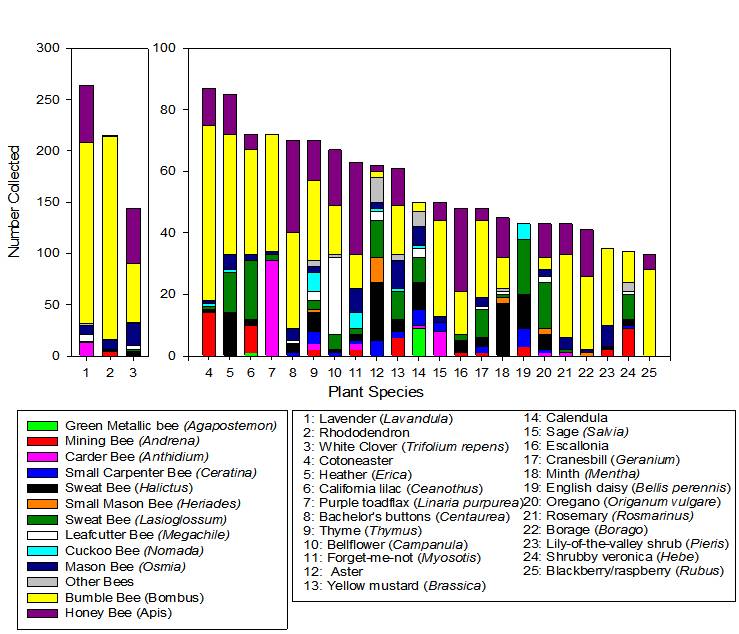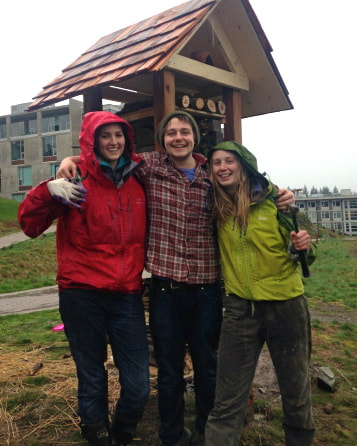 A Bombus vosnesenskii (vozzy bear bumblebee) covered in hibiscus pollen in a sidewalk garden in East Vancouver A Bombus vosnesenskii (vozzy bear bumblebee) covered in hibiscus pollen in a sidewalk garden in East Vancouver Creating a bee garden is one of the best things you can do to support our native bees! The main priorities here are providing food and nesting sites for different types of bees. Bee gardens are popping up all over, many in Vancouver. Some university campuses like UVIC and Berkeley have pollinator gardens, and Quest University in Squamish is soon to join them! (Stay tuned to this blog for how you can get involved in the fall.) Here are some guidelines to get you started on your own garden. Even doing a few things on this list will substantially help the bees! Priorities in a Bee Garden 1. Plant native plants Native plants and native bees have co-evolved together. Native bees may not be able to access non-native flowers, so focus on native plants in a bee garden (although non-native plants and weeds can be incredibly important, too! See below) Heavily hybridized flowers often stop producing nectar and pollen making them useless for bees. 2. Don't use pesticides Never use pesticides on your garden. Insecticides and fungicides have been found to be extremely dangerous to bees. Ask the managers of wherever you buy your plants and seeds from if they use neonicitinoids. These insecticides infiltrate all parts of the plant, including nectar and pollen, and affect the memory of bees making it difficult/impossible for them to find their way home. This is becoming a very hot topic, with neonics recently being found to be dangerous to birds, too! Pressure garden stores to stop using these pesticides. Home Depot, Lowe's, and Walmart plants are reportedly treated with neonics--do not buy from those stores. 3. Continuous flowering Plan your garden to have something flowering at all times. Bees need to eat every day, so try to provide flowers at all times of the season. Early and late flowering plants are especially beneficial. 4. Diversity of flower colours, shapes, and sizes Native bees are a diverse bunch! From large fuzzy bumblebees to tiny slick sweat bees, you can bet each type of bee will have its favourite type of flower. Cover your bases and plant a diverse array of flowers. 5. Plant large patches of a single flower It's easier for bees to forage if they can stick to a single species in an area. If you can't plant in large patches, don't fret, a single plant of one species if better than none! 6. Provide nest sites and materials Native bees nest in a variety of ways. Some like to live in holes in the ground, some nest in hollow stems, some in holes in wood, bumblebees will nest in abandoned rodent holes and birdhouses or at the base of ferns.... Ground nesters like bare, compact, undisturbed, well-draining soil in a variety of orientations from steeply sloping to flat. You can dig a pit and fill it with sand to create softer ground for bees, too. Plant grasses with hollow stems, and leave dead plants with hollow stems intact over the winter. Piles of hollow stems can be made to provide nesting areas. Provide a source of mud for mason bees to seal their nests with. Fuzzy plants, such as lambs ears, help carder bees make their nests. You can also make bee homes by drilling holes in wood, making bundles of hollow stems, or making wooden bumblebee boxes. Click here for more info from the Xerces Society. You can even make a insect hotel that is freestanding or mounted on a wall. 7. Providing water Provide a water container filled with rocks so the bees can climb down to the water easily. I have also observed bees drinking from moist soil and mud. Garden Management Strategies 8. Let the weeds live! Flowering weeds in the garden or lawn are great for bees! Clover, dandelions, etc. are fantastic. Let your lawn grow long, and let the weeds flower before you mow or pull them. 9. Leave vegetables to flower Let garden plants bolt and flower before pulling them out. The bees will thank you! Plant List Here is a list I have compiled from various sources that would be suitable for our area. Check out the resources below for more plant suggestions! Shrubs Blue elderberry, Sambucus cerulea California lilac, Ceanothus spp. Escallonia spp. Hardhack, Spirea douglasii King Edwards flowering currant, Ribes sanguineum Nootka rose, Rosa nutkana Ocean spray, Holodiscus discolor Red flowering currant, Ribes sanguineum Saskatoon, Amelanchier alnifolia Shrubby veronica, Hebe pinguifolia 'Pagei’ Rhododendrons Willow, Salix spp. Flowers/Herbs Under 30 cm Crocus spp. Thyme, Thymus spp. Sea blush, Plectritis congesta Sedum spp. Snow drops, Galanthus spp. Thrift, Armeria maritima Flowers/Herbs Over 30 cm Alyssum spp. Bee balm, Mondarda spp. Bellflower, Campanula spp. Chives, Allium schoenoprasum Columbine, Aquilegia spp Tickseed, Coreopsis spp. Cotoneaster spp. Cranesbill, Germanium macrorhizum, Geranium cantabrigiensis ‘Cambridge’ Douglas aster, Aster subspicatus Coneflower, Echinacea Blanket flower, Gaillardia spp. Heather, Calluna vulgaris Hollyhock, Alcea Giant hyssop, Agastache spp. Lambs ears, Stachys byzantina Lupin, Lupinus Penstemon ‘mexicali’ Purple toadflax, Linaria purpurea Sea holly, Eryngium maritimum Speedwell, Veronica spicata Tall and short grasses (species tbd) Threadleaf phacelia, Phacelia linearis Verbena vobariensis Yarrow, Achillea millefolium Fantastic Resources for Plants and General Bee Information Xerces Society Earthwise Society PDF of Native Bee Plants Environmental Youth Alliance Bee Garden Guide Bee Plant Guide SFU Elle Lab (psst I'm working here for the summer!!) David Suzuki Foundation Below is some data from the Elle Lab from Julie Wray anf Tiia Haapalainen on the most attractive garden plants for bees! Lavender is #1! (Make sure the lavender you buy is free of neonics, it is often treated in BC) Soon your yard will be buzzing with happy bees! Good luck and spread the word!
0 Comments
|
Michalina, Max, & BarrettMichalina, Max, and Barrett are students working on building a pollinator hotel on the Quest University Canada campus! Stay tuned for a community event, pollinator facts, and much much more!! ArchivesCategories |




 RSS Feed
RSS Feed